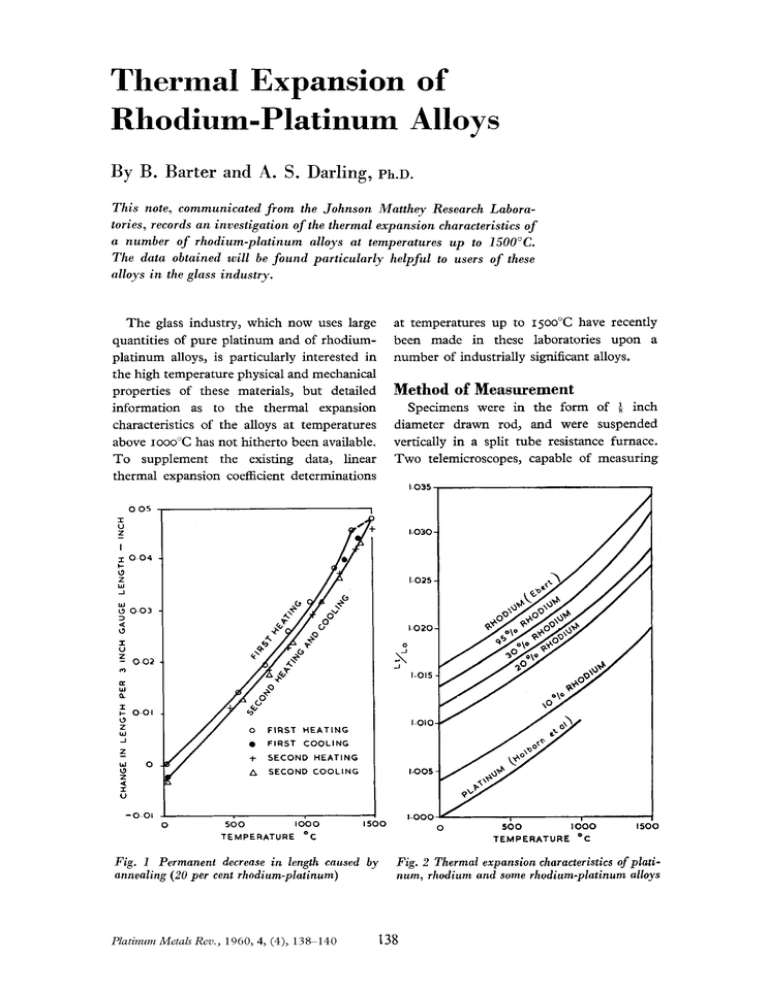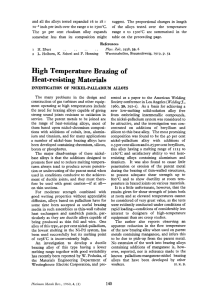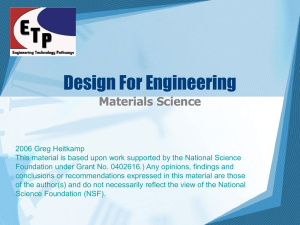Rhodium-Platinum Alloys - Johnson Matthey Technology Review
advertisement

Thermal Expansion of Rhodium-Platinum Alloys By B. Barter and A. S. Darling, Ph.D. T h i s note, communicated f r o m the Johnson Matthey Research Laboratories, records a n investigation of the thermal expansion characteristics of a number of rhodium-platinum alloys at temperatures u p to 1500°C. The data obtained will be found particularly helpful to users of these alloys in the glass industry. at temperatures up to 15ooOC have recently been made in these laboratories upon a number of industrially significant alloys. The glass industry, which now uses large quantities of pure platinum and of rhodiumplatinum alloys, is particularly interested in the high temperature physical and mechanical properties of these materials, but detailed information as to the thermal expansion characteristics of the alloys at temperatures above rooo"C has not hitherto been available. T o supplement the existing data, linear thermal expansion coefficient determinations Method of Measurement Specimens were in the form of 4 inch diameter drawn rod, and were suspended vertically in a split tube resistance furnace. Two telemicroscopes, capable of measuring 1-035 00 5 r z I 00 4 c u Z W _t 003 =f I U 5 0 0 2 m U w a :001 0 0 FIRST H E A T I N G FIRST COOLING + SECOND HEATING A SECOND COOLING V -001 J 0 500 TEMPERATURE 1000 I? - OC Fig. 1 Permanent decrease in length caused by annealing (20 per cent rhodium-platinum) Platinum Metals Rev., 1960, 4, (4), 138-140 3 TEMPERATURE OC Fig. 2 Thermal expansion characteristics of platinum, rhodium and some rhodium-platinum alloys I38 within limits of *O.OOOI inch, were used to determine the changes in length between reference marks on the specimens originally 3 inches apart. The experiments were carried out in air. The rods used for these tests were in the hard drawn condition when inserted into the cold furnace; it was found that annealing in situ induced permanent decreases in length. Some typical effects are illustrated in Fig. I, which relates to the 20 per cent rhodium alloy. The first heating curve was fairly smooth up to 1360"C, after which decreases in length at constant temperature were observed. After one hour at 15ooOC the cooling curve was found to be appreciably lower than the first heating curve. Measurements at room temperature showed a permanent de- crease in length of approximately 0.003 inch on the original 3 inch test length. Subsequent heating and cooling did not cause further appreciable changes in length. Experimental Results All the alloys studied exhibited this shrinkage effect to some extent, and the expansion curves plotted in Fig. 2 are those obtained during cooling after approximately one hour at 15ooT. All the curves are similar in character and agree fairly well with data for rhodium published by Ebert in 1938 ( I ) and with data for pure platinum published by Holborn, Scheel and Henning in 1919 (2). Although the expansion coefficients appear to increase slightly with rhodium content the effect is not pronounced, - Thermal Expansion of Rhodium-Platinum Alloys Lt 3 remperature "C Platinum (Ref. 2) 10% Rh 20% Rh 30% Rh 95% Rh Rhodium (Ref. I) I.ooo I .ooo I .ooo I.ooo I.ooo I .ooo I00 1.00090 1.0010 I.00063 I .00092 I .00095 I.00085 200 I .OO I83 I .0020 I.OO I40 I .OO I70 I .OO I80 1.00180 300 I .00278 I.0030 I.0023 I .0027 I.0027 I .00280 400 I .00376 I.004 I I .0032 I .0035 I.0036 I .00385 500 I.00477 I.0051 I .0043 I.0045 I .0045 I .00490 600 I .00580 I.006 I 1.0053 I .0054 I.0054 I .00600 700 I .00686 I .0072 I.0063 I .0064 I .0065 I,007 I 0 800 I.00794 I .0083 I .0075 I .0075 I .0076 I.00825 900 I.00905 I.0094 I .0087 I .0085 1.0087 I .00950 I000 I.01019 1.0106 I .0099 I .0097 1.0100 I .O1080 I100 1.01 17 1.01 12 1.0109 1.01 I 3 1.01210 I200 1.0131 1.0125 1.0121 1.0128 1.01350 I300 1.0144 1.0138 1.0135 1.0146 1.01500 I400 1.0158 1.0152 1.0149 1.0164 I.O I650 I500 1.0176 1.0167 1.0165 1.0184 1.01810 0 Platinum Metals Rev., 1960, 4, (4), 139 and all the alloys tested expanded 16 to 18 x I O - ~ inch per inch over the range o to 15ooOC. The 30 per cent rhodium alloy expands somewhat less than its composition might I 2 H. Ebert .. .. .. . . L. Holborn, K. Scheel and F. Henning suggest. The proportional changes in length of the alloys tested over the temperature range o to 15oo0C are summarised in the table on the preceeding page. References Z'hys. Zeit, 1938, 39, 6 Warmetabellen, Braunschweig, 1919, p. 54 High Temperature Brazing of Heat-resisting Materials INVESTIGATION OF NICKEL-PALLADIUM ALLOYS The many problems in the design and construction of gas turbines and other equipment operating at high temperatures include the need for brazing alloys capable of giving strong sound joints resistant to oxidation in service. The parent metals to be joined are the range of heat-resisting alloys, most of them based upon nickel-chromium compositions with additions of cobalt, iron, aluminium and titanium, and for many applications a number of nickel-base brazing alloys have been developed containing chromium, silicon, boron or phosphorus. The major disadvantage of these nickelbase alloys is that the additions designed to promote flow and to reduce melting temperatures always tend to produce severe penetration or undercutting of the parent metal when used in conditions conducive to the achievement of ductile joints, and they must therefore be used with great caution-if at allon thin sections. For moderate strength combined with good wetting properties without appreciable diffusion, alloys based on palladium have for some time been accepted as useful brazing media in such assemblies as thin-wall tubular heat exchangers and sandwich panels, particularly as they are ductile alloys capable of being produced as thin foil and wire. One alloy of this type, 40 per cent nickel-palladium, the lowest melting in the Ni-Pd system, has been used successfully but its melting point of 1238°C is inconveniently high. An investigation to develop a ductile brazing alloy of this type having a lower melting range together with good wettability has recently been reported by W. Feduska, of the Materials Engineering Department of Westinghouse Electric Corporation, and pre- Platinum Metals Rev., 1960, 4, (4), 140-140 sented as a paper to the American Welding Society conferencein Los Angeles (WeZdingJ., 1960, 39, 292-s). As a basis for achieving a new low-melting solid-solution alloy free from embrittling intermetallic compounds, the nickel-palladium system was considered to be attractive, and the investigation was concentrated on additions of beryllium and silicon to this base alloy. The most promising composition was found to be the 40 per cent nickel-palladium alloy with additions of 0.5 per cent silicon and 0.25per cent beryllium, this alloy having a melting range of 1115 to 1160OC and satisfactory ability to wet heatresisting alloys containing aluminium and titanium. It was also found to cause little penetration or erosion of the parent metal during the brazing of thin-walled structures, to possess adequate shear strength up to Soo°C and to show ductility at room temperature in brazed joints on various materials. It is a little unfortunate, however, that the results given for shear strength of joints both at room and at elevated temperatures cannot be considered of very great value, as the tests were evidently conducted under conditions of rapid loading-conditions of considerably less interest to designers of high-temperature equipment than are creep studies. The author also reports observing an apparent reduction in the flow temperature of the new brazing alloy when used on parent metals containing manganese, and infers this to be due to pick-up from the parent metal. No extension of the work into brazing alloys containing additions of manganese is, however, reported, nor is reference made to the known palladium-manganese-nickel brazing alloys that have been developed by other H. R. B. workers. 140





